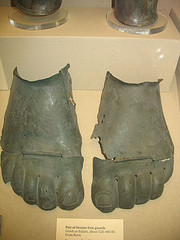
22 Feb Make a good impression
Squash box, foam box….
Some people ridicule it and some people swear by it.
Pick your side and you can extoll the virtues of a box of foam or rip it to shreds.
That being said, even now as you read this you have chosen your side right?
Let me bring some perspective to the Great Foam Box debate that rages among the Foot People of the world.
Keep reading and gain some perspective on both sides of the issue.
Semi Weight Bearing Foam impressions
The best way to use it.
This is a box with foam in it. The foot is pushed into the foam with the patient seated, and the foot in the neutral position, resting on the foam. This is pretty fast and there is really no cleanup required. This method accurately captures the fat pad displacement on the bottom of the foot. The craftsman does not need to add any additional plaster to the cast to accommodate soft tissue splay in the fabrication process.
Some practitioners will even pronate the foot slightly from neutral as the impression is being made to allow room for the foot go through it’s natural pronatory phase in midstance. Allowing the foot to pronate is necessary to store up energy as the foot prepares itself for adequate propulsion during toe off.
Who can I use it on?
You can use this method on patients that have a lot of soft tissue displacement. This is important to keep the orthotic edges and the medial arch from feeling painful to the patient.
The downside to this method is that it is not the best way to capture forefoot to rearfoot relationships. Also, it is difficult not to change the position of the 1st ray when pushing the foot into the foam. These are critical aspects of a functional foot orthotic. Our goal with a functional orthotic would be to alter the motion of the foot.
Foam casting works well when your goal is to make an accommodative orthotic. An accommodative device will support the foot and provide even weight distribution across the plantar surface of the foot.
How reliable is it?
Foam casting will not be the best way to produce consistent results. You can cast the same foot ten times in a row and you will get different arch heights among the casts.
The best times to use this method would be with rigid feet and with severely deformed feet. The rigid foot is not going to move much as you push the foot into the foam. A good example would be a foot with an uncompensated rearfoot varus deformity.
Severely deformed feet are typically fixed in their position also. A rocker bottom foot would be a prime example. This is when the navicular is dropped to the extent that it is the main contact point with the supporting surface.
You can view a step by step tutorial here
In the end, I think that foam casting is useful in certain cases. I think it is a good move for the practitioner to have some available to use. It can save time in the right situations and add to your versatility as an orthotic expert.

Kris Porter
Posted at 05:55h, 30 JuneWhere can we get foam boxes?
Joe Vasquez C.Ped.
Posted at 07:52h, 30 JuneHey Kris,
I get them from SPS (Southern Prosthetic Supply). I believe they have a warehouse in Atlanta…should get to you quickly from there…within a day or two. They have an estore to order online here…http://estore.spsco.com/storefrontB2BWEB/
Hope that helps!
Joe Vasquez C.Ped.
Posted at 07:53h, 30 JuneI get my plaster casting strips at SPS also…
Where do you buy your plaster strips from? Chances are, they might sell the foam boxes too…